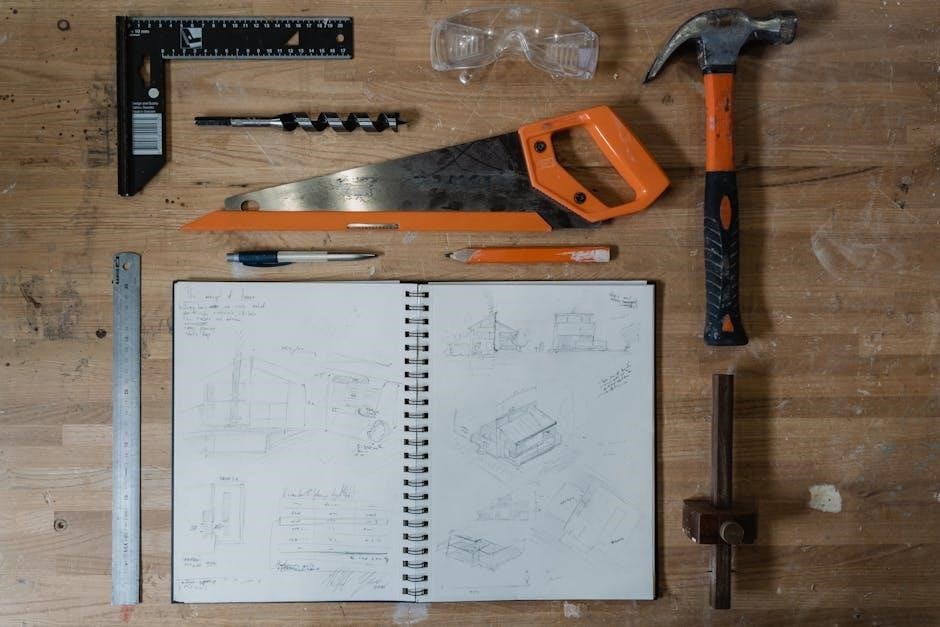Engine test stand plans provide detailed guidance for building a robust platform to safely test and tune engines outside of a vehicle, ensuring optimal performance and reliability.
Overview of Engine Test Stands
An engine test stand is a specialized platform designed to securely mount and operate an engine outside of a vehicle, allowing for testing, tuning, and diagnostics in a controlled environment. These stands are essential for mechanics, builders, and enthusiasts to evaluate engine performance, identify issues, and ensure proper operation before installation. Engine test stands vary in complexity, from basic setups with minimal features to advanced systems equipped with cooling, fuel, and electrical systems. They often include adjustable mounting points, vibration dampening, and instrumentation for monitoring parameters like RPM, temperature, and pressure. Portability and durability are key features, making them versatile tools for workshops, garages, or racing applications. A well-built engine test stand is indispensable for anyone working with engines, providing a safe and efficient way to test and refine their performance.
Importance of Engine Test Stands for Mechanics and Enthusiasts
Engine test stands are indispensable tools for mechanics and automotive enthusiasts, offering a safe and controlled environment to test, diagnose, and tune engines before installation. They allow for thorough evaluation of engine performance, identification of potential issues, and confirmation of proper operation. For professionals, test stands streamline troubleshooting and reduce the risk of damage to the vehicle. Enthusiasts benefit by ensuring their engines are finely tuned and ready for installation, saving time and effort. These stands also enable proper engine break-in and testing of modifications without risking the vehicle. By providing a reliable platform for engine testing, they are essential for both professional and hobbyist applications, ensuring reliability and performance.
Benefits of Building a Custom Engine Test Stand
Building a custom engine test stand offers numerous benefits, including tailored design to specific engine needs and budget. It allows for optimal performance, safety, and reliability during testing. A custom stand ensures compatibility with various engine types, whether for Chevy, Ford, or Mopar engines, and can be adjusted for different sizes and weights. This flexibility reduces costs compared to purchasing a pre-built stand and provides a sense of accomplishment for DIY enthusiasts. Additionally, a custom design enables incorporation of advanced features like cooling systems, fuel delivery, and instrumentation, making it a valuable long-term investment for mechanics and hobbyists alike.

Design Considerations for Engine Test Stands
Designing an engine test stand requires careful planning for structural integrity, material selection, and system integration to ensure safety, functionality, and optimal engine performance during testing.
Key Components of a Functional Engine Test Stand
A functional engine test stand requires several essential components, including a sturdy frame and base for stability, a secure engine mounting system, and reliable cooling and fuel systems. The frame must be robust to handle the engine’s weight and vibrations, while the mounting system ensures proper engine alignment and minimizes movement. A well-designed cooling system prevents overheating, and the fuel system delivers fuel safely and efficiently. Additionally, an electrical system with proper wiring and instrumentation, such as gauges for monitoring performance, is crucial. Vibration dampeners and noise reduction features enhance safety and usability. Together, these components ensure a safe and effective testing environment for engines.
Frame and Base Design for Stability and Support
The frame and base are the foundation of an engine test stand, ensuring stability and support during operation. Constructed from durable materials like steel or heavy-duty wood, the frame must be robust to withstand the engine’s weight and vibrations. A wide, sturdy base is essential to prevent tipping, with a design that evenly distributes the weight. The frame’s dimensions should align with the engine’s size and specifications to ensure proper alignment and support. Proper welding and bracing techniques are crucial for structural integrity. A well-designed frame and base provide a solid platform for mounting the engine and associated components, ensuring safe and reliable operation during testing.
Engine Mounting Systems for Secure Operation

A secure engine mounting system is critical for stable and safe operation of the test stand. Heavy-duty mounts or adapters specifically designed for engine test stands are recommended to handle the weight and forces generated during operation. These mounts should be bolted directly to the stand’s frame, ensuring proper alignment to prevent vibration or movement. Vibration dampeners or isolation mounts can be added to minimize noise and reduce wear on the stand. Proper installation ensures the engine remains securely fastened, allowing for smooth operation and accurate performance monitoring. A well-engineered mounting system is essential for maintaining safety and reliability while testing engines of various sizes and power levels.
Cooling System Requirements for Optimal Performance
A well-designed cooling system is essential for maintaining optimal engine temperatures during testing. A high-flow radiator paired with a powerful fan ensures efficient heat removal, especially for high-performance engines. Proper plumbing and secure connections are critical to prevent leaks and maintain consistent coolant flow. A coolant reservoir is necessary to accommodate expansion and contraction of the coolant as it heats and cools. Regular inspection and maintenance of the cooling system are vital to prevent overheating and ensure longevity. The system should be tailored to the specific engine’s needs, with considerations for airflow and heat dissipation. A reliable cooling system ensures safe and consistent engine operation during testing.
Fuel System Design for Reliable Fuel Delivery
A reliable fuel system is crucial for consistent engine performance during testing. The design should include a fuel tank with sufficient capacity for testing needs, either a standard tank or a purpose-built fuel cell. A fuel pump with the correct flow rate and pressure for the engine is essential to ensure steady fuel delivery. High-quality fuel lines rated for the fuel type should connect the tank to the engine. A fuel filter is necessary to remove contaminants, and the system must be properly grounded to prevent static electricity buildup. These components work together to provide a reliable and safe fuel delivery system, ensuring optimal engine operation and minimizing risks during testing.
Electrical System Configuration for Safe Operation
A well-configured electrical system is vital for safe and reliable engine test stand operation. Start with a suitable battery, typically a standard car battery, and include a battery charger to maintain power levels. A wiring harness connects the battery to the engine, ensuring all components receive power. The starter motor and ignition system are essential for engine ignition, while a starter relay controls the starter motor. A fuse box protects the electrical system from overloads, and all connections must be secure and insulated. Proper grounding of the system prevents static electricity buildup, reducing fire hazards. This configuration ensures safe and efficient operation, allowing precise control over engine functions during testing.
Instrumentation and Gauges for Performance Monitoring
Instrumentation and gauges are essential for monitoring engine performance during testing. A tachometer measures engine speed, while an oil pressure gauge ensures proper lubrication. A coolant temperature gauge monitors operating temperatures, preventing overheating. A voltmeter tracks battery voltage, indicating electrical system health. A fuel pressure gauge ensures consistent fuel delivery, and an air/fuel ratio gauge helps optimize engine tuning. A wideband oxygen sensor provides precise air/fuel mixture readings. These tools allow real-time monitoring of engine performance, enabling quick identification of issues. Accurate data logging and analysis are also possible, enhancing diagnostic capabilities. Proper instrumentation ensures a safe, efficient, and effective testing environment, helping to maximize engine performance and reliability.

Resources for Engine Test Stand Plans
Online resources, printed publications, and premium plans offer comprehensive guides for building engine test stands, catering to various skill levels and budgets with detailed instructions and materials.
Online Resources and Communities for DIY Enthusiasts
Online forums, websites, and communities offer a wealth of resources for DIY enthusiasts seeking engine test stand plans. Platforms like eBay and Etsy provide downloadable PDF plans, while forums and blogs share free tutorials and blueprints. Many sellers, such as FISHERMANRUSS, offer detailed diagrams and instructions for building custom stands. These resources cater to various skill levels, from basic to advanced, ensuring enthusiasts can find plans that match their needs. Additionally, online communities provide valuable tips, troubleshooting advice, and user experiences, fostering a supportive environment for DIY projects. These digital resources empower enthusiasts to create functional and personalized engine test stands efficiently.
Printed Publications and Manuals for Detailed Guidance
Printed publications and manuals provide comprehensive guidance for building engine test stands, offering detailed plans, diagrams, and step-by-step instructions. Automotive magazines and books often include dedicated sections on engine test stands, featuring material lists and illustrations. Libraries and bookstores offer access to these resources, while some automotive supply stores sell pre-designed plans. These publications cater to both beginners and advanced builders, ensuring a thorough understanding of the construction process. They are particularly valuable for those who prefer physical resources, offering a tangible and detailed approach to creating a functional engine test stand. These manuals are indispensable for ensuring accuracy and quality in your DIY project.

Premium Plans and Kits for Advanced Users
Premium engine test stand plans and kits are designed for advanced users seeking high-performance solutions. These plans often include detailed diagrams, material lists, and step-by-step instructions tailored for complex builds. Kits may feature pre-fabricated components, such as adjustable engine mounts or advanced cooling systems, ensuring precision and reliability. Premium options typically cater to enthusiasts working with high-performance or specialized engines, offering customization options to meet specific needs. Many premium plans are sold by reputable sellers, like FISHERMANRUSS on eBay, and include expert guidance for troubleshooting and optimization. These high-end resources are ideal for those aiming to create a professional-grade test stand, ensuring durability and scalability for future projects. They provide a polished, efficient solution for serious engine enthusiasts.

Safety and Functionality in Engine Test Stand Construction
Safety and functionality are paramount when building an engine test stand. Ensure structural integrity, proper vibration dampening, and secure mounting systems to prevent accidents and ensure reliable operation.
Safety Precautions During Construction and Operation
Safety is critical when constructing and operating an engine test stand. Always wear protective gear, including gloves and safety glasses. Ensure the stand is built with durable materials and proper welding techniques to avoid structural failure. The engine must be securely mounted to prevent movement during operation. Keep the area clear of flammable materials and ensure proper ventilation. Regularly inspect fuel and electrical systems for leaks or damage. Never operate the engine near open flames or sparks. Use a kill switch for emergency shutdown. Follow proper startup and shutdown procedures to avoid sudden engine kickback. Ensure all connections are secure and test the stand at low power initially. Always have a fire extinguisher nearby and maintain a safe distance during operation.
Ensuring Structural Integrity and Durability
Structural integrity is paramount for a reliable engine test stand. Use high-strength materials, such as steel, for the frame and base to support the engine’s weight and withstand vibrations. Proper welding techniques are essential to ensure durability and prevent failure. The frame should be designed with a low center of gravity to enhance stability and resist tipping. Regularly inspect the stand for signs of wear or damage, addressing issues promptly. Consider adding gussets or cross braces for added strength. Ensure all bolts and fasteners are securely tightened and periodically checked. A well-constructed stand will safely endure repeated use and varying engine loads, providing long-term reliability for testing and tuning engines.
Vibration and Noise Reduction Techniques
To minimize vibration and noise, incorporate damping materials like rubber mounts or vibration isolators between the engine and the stand. Use soundproofing foam or acoustic blankets around the engine to reduce noise. Ensure the frame is rigid and well-balanced to prevent resonance. Mounting the stand on a concrete floor or anti-vibration pads can further reduce transmission of vibrations. Properly securing all components and using balanced engine accessories will also help. Consider adding a noise barrier or enclosure to contain sound. Regular lubrication of moving parts and ensuring proper alignment of the engine can minimize operational noise. These techniques ensure a smoother, quieter operation, making the test stand more efficient and neighbor-friendly.

Tools and Materials Needed for Construction
Essential tools include welding equipment, drill presses, wrenches, and multimeters. Materials like steel beams, heavy-duty wood, and durable fasteners ensure structural integrity and longevity of the test stand.
Essential Tools for Building an Engine Test Stand
Building an engine test stand requires a range of tools, including welding equipment for constructing the frame, drill presses for precise hole alignment, and wrenches for securing bolts. A multimeter is essential for diagnosing electrical systems, while a hydraulic press may be needed for engine mounting. Steel beams, heavy-duty wood, and durable fasteners are critical materials for ensuring structural integrity. Proper safety gear, such as gloves and goggles, is vital for protecting yourself during construction. These tools and materials ensure a sturdy, functional, and safe engine test stand, enabling you to test engines effectively and troubleshoot issues with precision.
Recommended Materials for Strength and Longevity
For building a durable engine test stand, steel is the primary material due to its strength and ability to handle weight and vibrations. Mild steel is cost-effective and suitable for basic stands, while structural steel offers enhanced strength for heavier engines. A thickness of 1/4 inch for steel plates and 2×4 inch beams provides a balance between strength and practicality. High-strength bolts, such as grade 8, are essential for secure connections. Welding should be reinforced with techniques like double welding to ensure durability. Finishing with primer and paint protects against rust. Specialized engine mounts and durable materials for cooling and fuel systems, like copper tubing and fuel-resistant hoses, are crucial. Heavy-duty wiring ensures reliable electrical performance, making the stand both functional and long-lasting.
Assembly and Testing of the Engine Test Stand
Assemble the stand by following detailed plans, ensuring all components are securely mounted. Conduct initial testing to verify functionality, safety, and performance before running the engine.
Step-by-Step Assembly Guide
A comprehensive guide outlines the process of assembling an engine test stand, starting with preparing materials and tools. Begin by constructing the frame, ensuring stability and durability. Next, mount the engine securely using the specified mounting system. Install the cooling, fuel, and electrical systems according to the plans. Connect all components, such as gauges and wiring, carefully following the provided diagrams. Conduct a thorough inspection to ensure all parts are properly aligned and secured. Finally, perform initial testing to verify functionality and safety before running the engine. Detailed step-by-step instructions help ensure a successful assembly, minimizing risks and optimizing performance.
Initial Testing and Calibration Procedures
After assembling the engine test stand, begin with a thorough inspection to ensure all components are securely fastened and properly aligned. Check for any fluid leaks in the cooling and fuel systems. Verify that all electrical connections are secure and functioning correctly; Start by running the engine at a low idle to allow it to warm up gradually. Monitor the gauges, such as the tachometer, oil pressure, and coolant temperature, to ensure readings fall within acceptable ranges. Calibrate the ignition timing and fuel delivery system as specified in the plans. Use a data logger to record performance data for analysis. Perform a series of incremental tests, increasing the engine speed and load, while closely observing its behavior. This process ensures the engine operates smoothly and reliably before installation in a vehicle.

Maintenance and Upgrades for Engine Test Stands
Regular maintenance ensures optimal performance and longevity. Inspect and replace worn parts, clean components, and update systems for enhanced functionality and safety.
Regular Maintenance to Ensure Optimal Performance
Regular maintenance is critical to ensure your engine test stand operates efficiently and safely. Inspect the cooling system for leaks and blockages, and ensure proper coolant levels. Check fuel lines for damage or corrosion, and replace worn-out components promptly. Electrical systems should be tested for connectivity and function, with all connections secured. Lubricate moving parts and monitor vibration levels to prevent imbalance. Schedule periodic cleaning of surfaces and components to avoid debris buildup. Always use high-quality fluids and filters to maintain engine health. Document maintenance activities to track service history. Addressing issues early prevents major failures and extends the stand’s lifespan. Regular upkeep ensures reliability and safety during engine testing;
Upgrading and Customizing Your Engine Test Stand
Upgrading and customizing your engine test stand can enhance its functionality and adaptability to different engine types and testing requirements. Consider adding advanced features like data logging systems, adjustable mounting brackets, or interchangeable adapter plates for various engine sizes. Customizing the cooling system with a high-capacity radiator or upgrading to a digital dashboard for real-time monitoring can improve performance. Adding wheels or caster kits increases portability, while reinforced frames enhance durability for heavier engines. Implementing modular components allows for easy swaps between engines or testing configurations. These upgrades not only expand the stand’s versatility but also ensure it remains a valuable tool for future projects, making it a long-term investment for enthusiasts and professionals alike.
Troubleshooting Common Issues
Common issues with engine test stands include vibration, noise, and oil leaks. Address these by ensuring proper mounting, using vibration dampeners, and regularly inspecting for wear or damage.
Identifying and Resolving Potential Problems
When building or using an engine test stand, common issues like vibrations, noise, or oil leaks may arise. Properly identifying these problems is crucial for maintaining functionality and safety. Regular inspections of the frame, mounting systems, and connections can help detect potential weaknesses. Addressing vibration and noise requires ensuring the stand is level and using dampeners. Oil leaks can be mitigated by sealing all fluid lines and connections. Consulting engine test stand plans or manuals, along with online forums, provides valuable troubleshooting guidance. Always prioritize safety and perform repairs promptly to avoid further damage. A well-maintained test stand ensures reliable engine testing and longevity of the equipment.
Diagnosing and Repairing Electrical and Mechanical Failures
Diagnosing electrical issues in an engine test stand often involves checking wiring, connectors, and fuses for damage or corrosion. Use multimeters to test voltage and continuity, ensuring all components are functioning correctly. For mechanical failures, inspect mounting systems, bearings, and fasteners for wear or misalignment. Leaks in fuel or coolant systems can be traced to loose connections or damaged hoses. Consult engine test stand plans for specific troubleshooting steps. Regular maintenance, such as tightening bolts and replacing worn parts, can prevent failures. Detailed repair guides and diagrams from engine test stand plans pdfs provide step-by-step solutions, helping you quickly resolve issues and restore functionality to your test stand.
Building an engine test stand offers a rewarding DIY experience, ensuring safety, performance, and reliability. With detailed plans, enthusiasts can confidently construct and enjoy their own custom projects.
Final Thoughts on Building and Using an Engine Test Stand
Building a custom engine test stand is a valuable investment for any automotive enthusiast or mechanic. It provides a safe and controlled environment for testing, tuning, and diagnosing engine issues. With detailed plans available, enthusiasts can create a stand tailored to their specific needs, ensuring optimal performance and reliability. The hands-on experience not only enhances technical skills but also offers a sense of accomplishment. A well-designed test stand minimizes risks of damage and ensures the engine operates smoothly before installation. Regular maintenance and upgrades further extend its functionality. For those passionate about engines, constructing a test stand is a rewarding project that combines creativity with practical application, delivering long-term benefits for engine care and performance.
Encouragement for DIY Enthusiasts to Start Their Project
Embarking on a DIY engine test stand project is an exciting and rewarding endeavor for automotive enthusiasts. With accessible plans and resources available, enthusiasts can confidently begin their journey, tailoring the design to their specific needs. Building a test stand not only enhances mechanical skills but also fosters creativity and problem-solving. It provides a practical solution for testing engines safely and efficiently. The sense of accomplishment from creating a functional stand is immense, and it serves as a valuable tool for future projects. DIY enthusiasts are encouraged to embrace this challenge, as it offers a unique opportunity to combine passion with hands-on learning, resulting in a durable and personalized test stand that meets their unique requirements.
